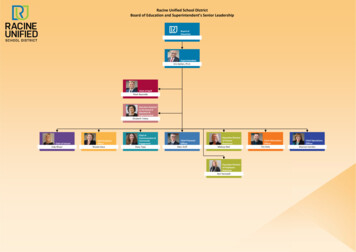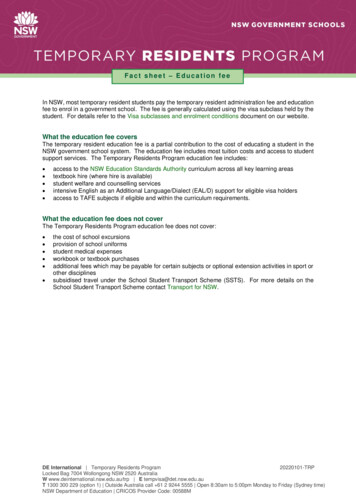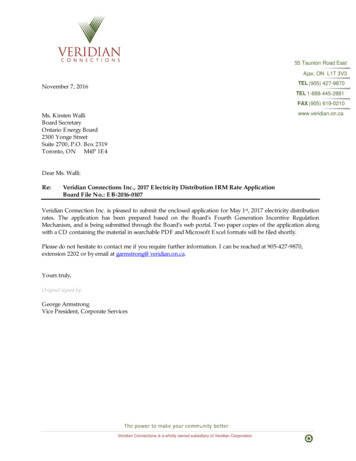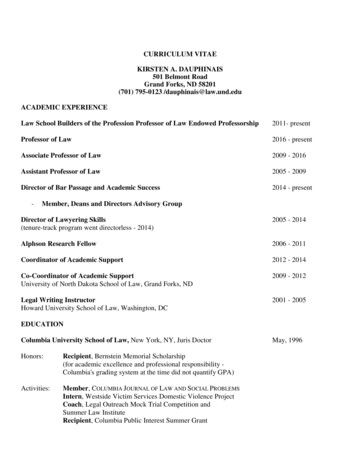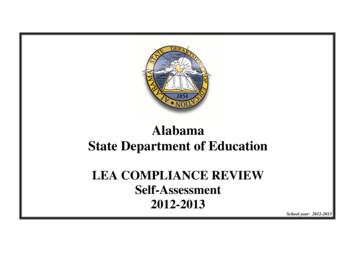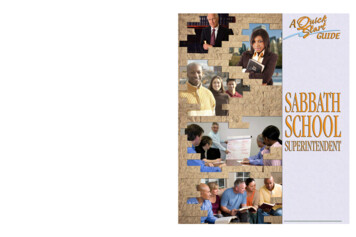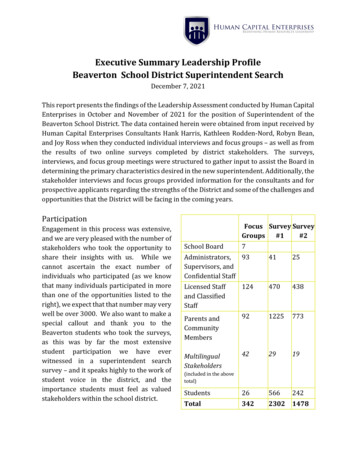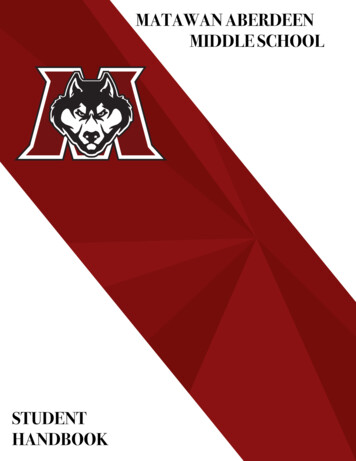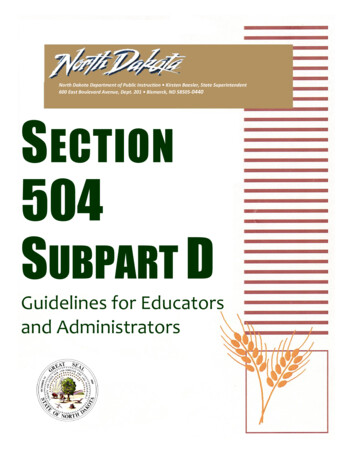
Transcription
North Dakota Department of Public Instruction Kirsten Baesler, State Superintendent600 East Boulevard Avenue, Dept. 201 Bismarck, ND 58505-0440SECTION504SUBPART DGuidelines for Educatorsand Administrators
Notice of NondiscriminationNorth Dakota Department of Public InstructionThe Department of Public Instruction does not discriminate on the basis of race, color, religion, sex, nationalorigin, disability, age, sex (wages) or genetics in its programs and activities. For inquiries regardingnondiscrimination policies, contact Lucy Fredericks, Director of Indian/Multicultural Education, Departmentof Public Instruction, 600 East Boulevard Avenue, Dept. 201, Bismarck, ND 58505-0440, Phone:701-328-1718.
CONTENTSSECTION 504/ADAIntroduction. . 1Acronyms/Definitions. 3Overview. 9Some Procedural Requirements . 13Section 504 Identification . 25Section 504 Accommodations/Services . 33Examples of Identified Students. 39OCR Questions and Answers . 55Comparison: Section 504 and Special Education . 73Appendices . 81A. Section 504—The Law and Regulations . 83B. Sample Forms . 107
CIVIL RIGHTS STATEMENT: In accordance with all regulations, guidelines and standardsadopted by the US Department of Education, the US Department of Agriculture and the NDHuman Rights Act, the ND Department of Public Instruction prohibits discrimination on thebasis of age, gender, race, color, religion, national origin, status with regard to marriage orpublic assistance, disability or political beliefs. All divisions of the Department of PublicInstruction will insure that no one is denied participation in, or denied the benefits of, orsubjected to discrimination under any department program or activity.Equal education opportunity is a priority of the ND Department of Public Instruction.
INTRODUCTIONThe purpose of these guidelines is to provide guidance to school staff regardingobligations under Section 504 of the Vocational Rehabilitation Act. These sameobligations are required by Title II of the Americans with Disabilities Act (ADA).These guidelines address Subparts D and E of the Section 504 regulations regardingstudent issues.PurposeSection 504 was implemented to prevent discrimination against individuals withdisabilities in federally funded programs. Section 504 of the Rehabilitation Act wasenacted in 1973. These federal regulations were implemented in 1977, and haveseven sections:Subpart ASubpart BSubpart CSubpart DSubpart ESubpart FSubpart GGeneral ProvisionsEmployment PracticesProgram AccessibilityPreschool, Elementary, and Secondary Education RequirementsPostsecondary Education RequirementsHealth, Welfare, and Social ServicesProcedures"Handicapped individuals" will hereafter be referred to as “individuals withdisabilities" in order to be consistent with current educational terminology.Enforcement/OversightFor many years, the main area of enforcement of Section 504 has been employmentissues for individuals with disabilities. However, within the last several years, theOffice for Civil Rights (OCR) has become more active in the provisions of Section 504regarding the education of students with disabilities.RequirementSection 504 prohibits discrimination against any individuals with disabilities bypublic schools receiving federal financial assistance.ManagementSection 504 should be a general education management responsibility.Section 504 Guidelines for Educators1
SECTION 504 EXAMPLES OF DISCRIMINATIONThe following are some examples of how discrimination has occurred againstindividuals with disabilities:1. A student with a disability is denied recognition as an honor roll student because oneclass is in the special education resource room.2. A student is expelled from school for misbehavior that is related to his/her disability.3. The school refuses to provide bus transportation that is as short in duration (withinreason) as provided to student without disabilities.4. The school refuses to allow a student with a disability the opportunity to audition forathletic teams or other extracurricular activities.5. The school refuses to dispense medication to a student who needs it to benefitfrom education.6. The high school counselor fails to provide information about the special provisions ofcollege board examinations to students with disabilities.7. The school refuses to provide a modified adaptive physical education program for astudent who is obese and cannot participate in regular physical education.8. The school does not provide an interpreter for a parent to attend a school meetingregarding his/her student.9. The school does not provide an interpreter for a parent who is deaf to attend a schoolmeeting regarding his/her student.10. Students with disabilities are denied access to extracurricular activities.North Dakota Department of Public Instruction2
ACRONYMS/ DEFINITIONSThe following are commonly used acronyms and definitions used in Section 504and special education.ADA — Americans with Disabilities ActADAAG — Americans with Disabilities Act Accessibility GuidelinesADD — Attention Deficit DisorderADHD — Attention Deficit Hyperactivity DisorderAG — Annual GoalAP — Accommodation PlanAPR — Annual Performance ReportAYP — Annual Yearly ProgressBIE — Bureau of Indian EducationCD — Cognitive DelayCFR — Code of Federal RegulationsDD — Developmental DisabilitiesDNR — Do Not ResuscitateDOE — Department of EducationED — Emotionally DisturbedEI — Early InterveningESY — Extended School YearFAPE — Free Appropriate Public EducationFERPA — Family Educational Rights and Privacy ActHI — Hearing ImpairedIDEA — Individuals with Disabilities Education Act—Special EducationSection 504 Guidelines for Educators3
IEP — Individualized Education ProgramIFSP — Individualized Family Service PlanLEA — Local Education AgencyLRE — Least Restrictive EnvironmentLD — Learning DisabilityOCR — Office for Civil RightsOHI — Other Health ImpairedOSEP — Office of Special Education ProgramsOT — Occupational TherapyPart B — Special Education for School-Aged StudentsPart C — Special Education for Infants and Toddlers Birth through Two YearsPT — Physical TherapyRtI—Responsiveness to InterventionSEA — State Education AgencySection 619 — Special Education for Three to Five Year OldsSPP — State Performance PlanTTY — A Telecommunication Device for the Deaf (Teletypewriter)VI — Visually Impaired504 — Section 504 of the Rehabilitation ActNorth Dakota Department of Public Instruction4
DEFINITIONSThe following are definitions that will be used in this manual.ACCOMMODATIONS—Adaptations made by classroom teacher(s) and other schoolstaff to enable the students to access their educational program. In some cases, aSection 504 plan should be developed outlining accommodations.ADA ACCESSIBILITY GUIDELINES (ADAAG)—Standards used to meet Section504/ADA accessibility requirements for the design, construction, and alteration ofbuildings.AMERICANS WITH DISABILITIES ACT (ADA)—A civil rights law that prohibitsdiscrimination against persons with disabilities in the areas of accessibility,employment, public services, public accommodations, transportation, andcommunication. Congress recently passed the ADA Amendments of 2009.BARRIER-FREE ENVIRONMENT—A school environment that contains no obstaclesto accessibility and usability by students and other individuals with disabilities.Barriers can be physical and nonphysical.CONSENT — Written parent permission before initial evaluation and initialeducation placement.CONTAGIOUS DISEASES PROTECTED UNDER 504—Contagious diseases arethose that can be transmitted from person to person. Examples are diseases such asAIDS, HIV, and tuberculosis.EARLY INTERVENING TEAM—A group of school staff knowledgeable aboutstudents “at risk.” The team assists other teachers and suggests accommodations tohelp the student succeed in his/her general education program. This is sometimesreferred to as a Building Level Support Team. Every effort should be made to keep thestudent in the general education program.FAMILY EDUCATIONAL RIGHTS AND PRIVACY ACT (FERPA)—the federal lawand regulations that address student record keeping and confidentiality.Section 504 Guidelines for Educators5
FREE APPROPRIATE PUBLIC EDUCATION (FAPE)—Related aids and services thatare designed to meet individual educational needs of students with disabilities asadequately as the needs of nondisabled persons are met.INDIVIDUALS WITH DISABILITIES EDUCATION ACT (IDEA)—Federal specialeducation law and regulations.MAJOR LIFE ACTIVITY—Functions such as walking, breathing, learning, reading,concentrating, thinking, communicating, seeing, speaking, caring for one’s self,working, helping, eating, sleeping, standing, lifting, bending, and operation of a bodilyfunction.OFFICE FOR CIVIL RIGHTS (OCR)—this federal agency has three primaryresponsibilities: investigating complaints, conducting compliance reviews, andproviding technical assistance. There are 10 regional offices located throughout theUnited States.PHYSICAL OR MENTAL IMPAIRMENT—(1) any physiological disorder orcondition, cosmetic disfigurement, or anatomical loss affecting one or more of thefollowing body systems: neurological; musculoskeletal; special sense organs;respiratory, including speech organs; cardiovascular; reproductive; digestive;genitourinary; hemic and lymphatic; skin; and endocrine; or (2) any mental or physicaldisorder, such as mental retardation, organic brain syndrome, emotional or mentalillness, and specific learning disabilities.The term “physical or mental impairment” includes, but is not limited to, such diseasesand conditions as orthopedic, visual, speech, and hearing impairments; cerebral palsy;epilepsy; muscular dystrophy; multiple sclerosis; cancer; heart disease; diabetes;mental retardation; emotional illness; drug addiction; and alcoholism.PROGRAM ACCESSIBILITY—the school will ensure programs and activities areaccessible to and usable by persons with disabilities. In many instances, programs andactivities may be made accessible through slight modifications and adjustments inprocedures, practices, and policies. In others, building renovation or construction maybe required. Structural change is required only where program accessibility cannot beachieved effectively through other means.PROGRAM OR ACTIVITY—in the context of Section 504/ADA, this includes alloperations of State and local agencies that receive federal funds. This includes colleges,universities, and/or school districts.North Dakota Department of Public Instruction6
PUBLIC ENTITY—Any school, organization, agency, or office that receives federalfunding and is therefore, obligated to follow Section 504/ADA requirements.PUBLIC NOTICE—The school is required to provide public notice and internal notice(i.e., to staff, individuals with disabilities, and students) stating it does not discriminateon the basis of a disability.QUALIFIED STUDENT—Any student who has a physical or mental impairment thatsubstantially limits one or more major life activities.SECTION 504—The Vocational Rehabilitation Act of 1973 that guarantees specificrights in federally funded programs and activities to people who qualify as disabled.Section 504 states, “No otherwise qualified disabled individual in the United States.shall, solely by reason of a disability be excluded from the participation in, be deniedthe benefits of, or be subjected to discrimination under any program or activityreceiving federal financial assistance.”SECTION 504/ADA COORDINATOR—The school employing 15 or more personsmust assign a person to coordinate compliance with Section 504 regulations. It isrecommended that all schools appoint a 504/ADA coordinator. It is recommended thatthe same individual serve as the Americans with Disabilities Act Coordinator and be ageneral educator.SECTION 504 CASE MANAGER—This is usually the primary school staff memberproviding accommodations for a specific student. Case managers could includecounselors, school nurses, and general education teachers. The case manager maintainsthe Section 504 student file.SELF-EVALUATION—The Americans with Disabilities Act requires that federal fundrecipients evaluate their programs, physical accessibility, and employment practices todetermine the extent to which programs and activities require modification to ensurefull participation by students with disabilities. These evaluations should be revisitedannually by the Section 504/ADA Coordinator.TRANSITION PLAN—If a school determines that structural modifications arenecessary to meet Section 504/ADA program accessibility requirements, the schoolmust develop a plan specifying the steps necessary to complete such changes and thetime frame for completion.Section 504 Guidelines for Educators7
North Dakota Department of Public Instruction8
OVERVIEWSection 504/ADA is a civil rights statute aimed at discrimination against individualswith disabilities. Like other statutes of Title VI (race) and Title IX (gender), Section504/ADA focuses on discrimination based on disability. All programs or activitiesof the school are covered by Section 504/ADA obligations.There is no State or federal funding provided to assist in complying with Section504. All costs are the obligation of the general school district budget. Many schoolshave established a Section 504 line item in their general fund budget to covernecessary accommodations for individuals with disabilities.REGULATIONSSection 504 regulations have several areas that are particularly important forschools: Subpart B—employment practices, Subpart C—program accessibility, andSubparts D and E—requirements for preschool, elementary, secondary, andpostsecondary education. These guidelines will focus on Subparts D and E.SUMMARY OF SUBPARTS A–ESUBPART A: GENERAL PROVISIONSThis part of the regulations outlines the nondiscriminatory responsibilities of schoolsthat receive federal funds or are a public entity. No person, on the basis of adisability, shall be excluded from participation in, be denied the benefits of, or besubjected to discrimination under any program that benefits from federal funding oris a public entity.SUBPART B: EMPLOYMENT PRACTICESNo qualified person shall, on the basis of his/her disability, be subjected todiscrimination in employment by any program or activity that receives federal fundsor is a public entity.The school must make reasonable accommodations for employees with knownphysical and mental impairments unless the accommodation would impose anundue hardship on the operation of the school’s program. Examples of reasonableSection 504 Guidelines for Educators9
accommodations would include making facilities accessible to and usable bypersons with disabilities, job restructuring, part-time or modified work schedules,and acquisition or modification of equipment or devices.SUBPART C: PROGRAM ACCESSIBILITYNo individual with a disability shall be denied the benefits of, be excluded fromparticipation in, or be otherwise subjected to discrimination under any program oractivity because facilities are inaccessible or unusable. Building and programaccessibility is applicable to any individual with disabilities accessing any activities orprograms in that school building.The regulation contains two standards to be used in determining whether programsand activities are accessible to individuals with disabilities. One standard deals with“existing” facilities; the other deals with “new” construction. The term “existingfacility” means the facility was in existence or in the process of construction beforeJune 3, 1977, the effective date of the regulation. The term “new construction” meansgroundbreaking that took place on or after the effective date of the regulation.Leased facilities (mobile units) that are leased or constructed with federal funds arerequired to meet the standards of new construction. Other leased units are required to meetthe standards of existing facilities.The standard for a facility existing before June 3, 1977, for 504 or January 26, 1992, forADA requires that federally assisted programs or activities operated in that facilitymust, when viewed in their entirety, be readily accessible. This standard does not requirethat every facility or part be accessible so long as the program or activity as a whole isaccessible. Thus, recipients need not make structural changes to facilities that existedbefore June 3, 1977 for 504 or before January 26, 1992, for ADA where other alternativemethods are effective in making programs and activities accessible so long as priorityconsideration is given to offering the services in the most integrated settingappropriate.One example of an alternative method in a school would be the relocation of classes,activities, or services to an accessible site. Facility alteration or new construction isrequired to achieve program accessibility only if sufficient relocation of classes,activities, or services cannot be housed in an existing facility. In meeting the objectiveof program accessibility, the school must take precautions not to isolate or concentratestudents with disabilities in settings away from students without disabilities.North Dakota Department of Public Instruction10
The regulation requires that all new construction begun after June 3, 1977, for 504 orJanuary 26, 1992, for ADA, as well as alterations to existing facilities, must be designedand constructed so as to make facilities accessible and usable by individualswith disabilities.SUBPART D: REQUIREMENTS FOR PRESCHOOL, ELEMENTARY,MIDDLE LEVEL, JUNIOR HIGH, SECONDARY EDUCATION, ANDADULT EDUCATION PROGRAMPreschool, elementary, middle level/junior high, and secondary programs must take intoaccount the needs of qualified persons with disabilities in determining the aid, benefits, orservices to be provided under these programs or activities.The school must provide a free appropriate public education to students withdisabilities in its jurisdiction who are eligible under Section 504. Instruction must beindividually designed to meet the needs of those students as adequately as the needs ofstudents without disabilities. This standard of what is “appropriate” differs from theIDEA “appropriate” standard, which requires the school to design a programreasonably calculated to confer educational benefit. An appropriate education underSection 504/ADA requires that the services be effective and fair.Although Section 504 does not require schools to develop an Individualized EducationProgram with annual goals or an accommodation plan, the school should providewritten documentation for each student identified and provided accommodationsand/or services under Section 504. If the Building Level Support Team suspects a needfor accommodation, a referral should be made, evaluations conducted, and possibleidentification determined by a team knowledgeable about the student. If the student isidentified, the team might develop a Section 504 Accommodation Plan.The quality of educational services provided to individuals with disabilities must beequivalent to the services provided to individuals without disabilities. Teachers,administrators, staff, and parents should receive ongoing training in the instruction ofindividuals with disabilities and be knowledgeable about the disability, appropriatematerials, and equipment. The Section 504 Coordinator will be responsible to develop andimplement staff and parent training.RESPONSIBILITYSection 504 should fall under the management of general education. The figure on the next pageillustrates some obligations of general education under Section 504 and their relationshipwith school personnel roles. The schoolSection 504 Guidelines for Educators11
staff and parents should collaborate to help guarantee that students are providedaccommodations through general education. The exception to this standard is a student whohas been determined eligible as having a disability under the Individuals with DisabilitiesEducation Act (IDEA). Such a student could receive special education services under IDEAand accommodations required under Section 504. Many schools will include the Section 504accommodations on the IEP rather than developing two separate documents.RESPONSIBILITIES IN THE SECTION 504 PROCESSStudent andParent Are involved in suggesting accommodations.Participate in meetings.Benefit from program.SchoolPrincipals andSchool Staff Conduct nondiscriminatory practices in classrooms.Refer/identify/evaluate students.Encourage parent involvement.Develop program modifications and accommodations.504Coordinator* Coordinates Section 504 procedures.Provides staff and parent training.Manages Section 504 grievance procedures.Helps conduct the self-evaluation.Superintendent Designates 504 Coordinator.Provides annual notice to parents/students.Provides continuing notice to students/employees.School Board Establishes policy on nondiscrimination.Develops grievance procedure.Develops hearing procedure.RESPONSIBILITY* Parents and school personnel must be notified as to who is the 504 coordinator.If possible, the Coordinator should be a person from general education.North Dakota Department of Public Instruction12
SOME PROCEDURAL REQUIREMENTSTo be in compliance with Section 504, schools must have policies and procedures inplace for the following:1. Provide written assurance of nondiscrimination whenever the school receivesfederal money (e.g., on the LEA application). [34 CFR § 104.5(a)]2. Designate an employee to coordinate compliance with Section 504/ADA (if thereare more than 15 employees). [34 CFR § 104.7(a)]3. Provide grievance procedures to resolve complaints of discrimination (if morethan 15 employees): mediation, complaint process, and due process hearings.[34 CFR 104.7(b)]4. Provide notice to students and parents. A separate notice should be available foremployees, unions, and professional organizations of nondiscrimination inadmission or access to, treatment at, and employment in its programs or activities(if more than 15 employees). Notice must be included in student/parenthandbook. [34 CFR §104.8]5. The school will identify and locate qualified students with disabilities withintheir jurisdiction. [34 CFR 104.32]6. Annually notify persons with disabilities and their parents or guardians of theschool’s responsibilities under Section 504/ADA. [34 CFR § 104.32(b)]7. Provide parents or guardians with procedural safeguards:a. Notice of their rightsb. An opportunity to review relevant recordsc. An impartial hearing. It is important that parents or guardians be notified oftheir right to request a hearing regarding the identification, evaluation, oreducational placement of individuals with disabilities [34 CFR § 104.36].d. Review of procedures. Compliance with the procedural safeguards underspecial education is one way of meeting these requirements.8. Conduct a self-evaluation of the school facilities, programs, and policies to ensurethat discrimination is not taking place. [34 CFR § 104.6 (c)] This study should beconducted with the assistance of interested persons, including persons withdisabilities.Section 504 Guidelines for Educators13
The next few pages will clarify and provide suggested procedures for complyingwith the procedural requirements under Section 504.PROCEDURE ONE:34 CFR 104.56 (A)WRITTEN ASSURANCE OF NONDISCRIMINATIONWhenever a school applies for State or federal monies, it must assure that it does notdiscriminate on the basis of race, sex, color, national origin, age, or disability. Thisrequirement is done routinely by all schools.PROCEDURE TWO:34 CFR 104.7 (A)SECTION 504 COORDINATORThe general provisions of Section 504/ADA, together with other federalnondiscrimination laws, require the designation of a person to coordinate the school’sefforts to comply with these laws. Coordination activities could include some or all ofthe following:Suggested Responsibilities of the Section 504 Coordinator Ensure nondiscriminatory educational practices. Establish and monitor a Section 504/ADA referral/identification/review process. Maintain data on Section 504/ADA referrals. Conduct staff and parent awareness and training activities concerning Section504/ADA requirements. Implement Section 504/ADA grievance procedures. Monitor Section 504/ADA budget. Consult with the Special Education Coordinator. Serve as the school liaison with the regional Office for Civil Rights.The Section 504/ADA Coordinator could be someone already employed by theschool. A general education staff member or school counselor who is knowledgeableabout federal laws and regulations would be preferred. In many cases, this personoversees and is responsible for other civil rights laws.— Best Practice —General Education AdministratorSchool CounselorNorth Dakota Department of Public InstructionSchool Nurse14
PROCEDURE THREE:34 CFR 104.7 (B)SAMPLE SCHOOL GRIEVANCE PROCESSSection IIf any person believes that the school or any of the school’s staff have inadequatelyapplied the regulations of (1) Title VI of the Civil Rights Act of 1964, (2) Title IX of theEducation Amendment Act of 1972, (3) Section 504 of the Rehabilitation Act of 1973, or(4) the Americans with Disabilities Act, he/she may bring forward a grievance to theschool’s Section 504/ADA coordinator. It should be understood by the individual(s)involved that a complaint can be made to the Office for Civil Rights without goingthrough the school’s grievance procedures. The grievance procedures are to provide fora prompt and equitable resolution of a complaint.Section IIThe school 504 coordinator, on request, will provide a copy of the school’s grievanceprocedure and investigate all complaints in accordance with this procedure. Thegrievance procedure should include a statement that a copy of each of the acts and theregulations on which this notice is based may be found in the coordinator’s office.The person who believes he/she may have been discriminated against based ondisability shall discuss the grievance and give the completed grievance form to theschool Section 504 coordinator who shall in turn investigate the complaint and replywith an answer to the complainant.Step 1A written grievance form signed by complainant shall be submitted to the schoolSection 504 Coordinator. The coordinator shall further investigate the matters ofgrievance and reply in writing to the complainant within 10school days.Step 2If the complainant wishes to appeal the decision of the school Section 504Coordinator, he/she may submit a signed statement of appeal to the districtadministrator within 10 school days after receipt of the coordinator's response.The coordinator and superintendent should not be the same individual. Thesuperintendent shall meet with all parties involved, formulate a conclusion, andrespond in writing to the complainant within 10 school days.Section 504 Guidelines for Educators15
Step 3If the complainant remains unsatisfied, he/she may appeal through a signedwritten statement to the school board of education within 10 school days ofhis/her receipt of the district’s response in Step Two. In an attempt to resolve thegrievance, the board shall meet with the concerned parties and theirrepresentative within 15 school days of the receipt of such an appeal. A copy ofthe board's disposition of the appeal shall be sent to each concerned party within10 school days of this meeting.Step 4The complainant may file a complaint with the Office for Civil Rights at any timebefore or during the grievance procedures.North Dakota Department of Public Instruction16
SECTION 504SCHOOL GRIEVANCE FORMDate:Name: Title:Student:Address:Phone:1. Summary of why your child’s civil rights have been violated—What is the problem?2. How can the problem be resolved?Please describe any corrective action you wish to see taken with regard to the possible violation. You may also provide other information relevant to this grievance.If others are affected by the possible violation, please give their names and/orpositions:Signature of ParentDateSignature of Section 504 CoordinatorDate ReceivedSection 504 Guidelines for Educators17
MEDIATIONMediation is not a requirement under Section 504 but should be considered a bestpractice. Most of the time, parents and school staff agree on issues regarding evaluation,identification, program, and placement of students with disabilities. However, there aretimes when disagreement occurs.Conflict is often inevitable, but it need not produce negative results. If the parent and schoolare unable to resolve a conflict concerning a student with a disability, then mediation is anavailable alternative to a long and expensive due process hearing.Section 504 does not require mediation. Mediation is completely voluntary. It should notinterfere with any procedural safeguards, including a request for a due process hearing orfiling a complaint with OCR. Mediation costs are the responsibility of the school.The mediator is a neutral third
1. A student with a disability is denied recognition as an honor roll student because one class is in the special education resource room. 2. A student is expelled from school for misbehavior that is related to his/her disability. 3. The school refuses to provide bus transportation that is as short in duration (within

